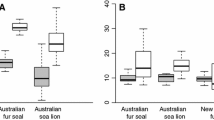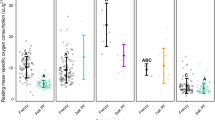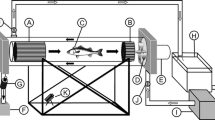Abstract
The goal of this study was to characterize the cardiorespiratory patterns of male South American sea lions (SASLs, Otaria flavescens) resting on land. We recorded respiratory and heart rate (n = 360 individuals studied) by observing the nostrils, chest movements and the impact of the heart on the thoracic wall. The sea lions breathe apneustically with a pause on inspiration, representing 74% of the respiratory cycle. The mean breathing frequency was 3.2 ± 1.0 breaths min−1, with a breathing cycle presenting periods of bradypneas, tachypneas, and long-term post-inspiratory pauses. The normal heart rate (nHR) was 73.4 ± 14.5 beats min−1 and no significant differences were observed between age classes. All animals showed variability in HR in relation to respiratory phases (Inspiration: 101.2 ± 18.4 beats min−1; post-inspiratory pause: 73.4 ± 14.5 beats min−1; expiration: 64.6 ± 17.7 beats min−1), consistent with respiratory sinus arrhythmia (RSA). The mean HR (measured during all respiratory phases) was 79.9 ± 22.7 beats min−1, and was significantly different between age classes. The total duration of respiratory cycle, and duration of both inspiration and expiration, decreased with an increment in ambient temperature, with no variation in the pause duration. Heart rate during pause and expiration was significantly higher during high temperatures. Similar changes in cardiorespiratory patterns have been reported in other pinnipeds. Our results showed ontogenetic differences in development and typical variations with environmental and behavioral variables.
Graphical abstract






Similar content being viewed by others
Data availability
The datasets generated during and/or analyzed during the current study are available from the corresponding author on reasonable request.
References
Andersen HT (1966) Physiological adaptations in diving vertebrates. Physiol Rev 46:212–243. https://doi.org/10.1152/physrev.1966.46.2.212
Andrews RD, Jones DR, Williams JD, Thorson PH, Oliver GW, Costa DP, Le Boeuf BJ (1997) Heart rates of northern elephant seals diving at sea and resting on the beach. J Exp Biol 200:2083–2095. https://doi.org/10.1242/jeb.200.15.2083
Andrews RD, Costa DP, Le Boeuf BJ, Jones DR (2000) Breathing frequencies of northern elephant seals at sea and on land revealed by heart rate spectral analysis. Respir Physiol 123:71–85. https://doi.org/10.1016/S0034-5687(00)00168-7
Bartholomew GA (1954) Body temperature and respiratory and heart rates in the northern elephant seal. J Mammal 1954:211–218. https://doi.org/10.2307/1376035
Bates D, Mächler M, Bolker B, Walker S (2014) Fitting linear mixed-effects models using lme4. arXiv. https://doi.org/10.48550/arXiv.1406.5823
Ben-Tal A, Shamailov SS, Paton JFR (2012) Evaluating the physiological significance of respiratory sinus arrhythmia: looking beyond ventilation–perfusion efficiency. J Physiol 590(8):1989–2008. https://doi.org/10.1113/jphysiol.2011.222422
Blackwell SB, Le Boeuf BJ (1993) Developmental aspects of sleep apnoea in northern elephant seals, Mirounga angustirostris. J Zool 231(3):437–447. https://doi.org/10.1111/j.1469-7998.1993.tb01930.x
Blawas AM, Nowacek DP, Rocho-Levine J, Robeck TR, Fahlman A (2021) Scaling of heart rate with breathing frequency and body mass in cetaceans. Philos Trans R Soc B 376:20200223. https://doi.org/10.1098/rstb.2020.0223
Boily P, Lavigne DM (1997) Developmental and seasonal changes in resting metabolic rates of captive female grey seals. Can J Zool 75(11):1781–1789. https://doi.org/10.1139/z97-807
Boyd IL, Woakes AJ, Butler PJ, Davis RW, Williams TM (1995) Validation of heart rate and doubly labelled water as measures of metabolic rate during swimming in California sea lions. Funct Ecol 9:151–160. https://doi.org/10.2307/2390559
Boyd IL, Bevan RM, Woakes AJ, Butler PJ (1999) Heart rate and behavior of fur seals: implications for measurement of field energetic. Am J Physiol Heart Circ Physiol 276:844–885. https://doi.org/10.1152/ajpheart.1999.276.3.H844
Burns JM, Costa DP, Harvey JT, Frost K (1999) Physiological Development in Juvenile Harbor Seals. In: 13th Biennial Conference on the Biology of Marine Mammals, Wailea, Hawai, USA, pp 26–27
Butler PJ, Woakes AJ, Boyd IL, Kanatous S (1992) Relationship between heart rate and oxygen consumption during steady-state swimming in California sea lions. J Exp Biol 170:35–42. https://doi.org/10.1242/jeb.170.1.35
Castellini MA (1994) Apnea tolerance in the elephant seal during sleeping and diving: physiological mechanisms and correlations. In: Le Boeuf and Laws (eds) Elephant seals, population ecology, behavior, and physiology. University of California press, Berkeley
Castellini M (1996) Dreaming about diving: sleep apnea in seals. Physiology 11(5):208–214. https://doi.org/10.1152/physiologyonline.1996.11.5.208
Castellini MA (2002a) Thermoregulation. In: Perrin W and Thewissen (eds) Encyclopedia of Marine Mammals. Academic Press, San Diego, California, pp 1245–1250
Castellini MA (2002b) Sleep in aquatic mammals. In: Carley and Radulovacki (eds) Animal models of sleep related breathing disorder. Lung biology in health and disease. Marcel-Dekker, New York, pp 336–355
Clark CA (2004) Tracking changes: postnatal blood and muscle oxygen store development in harbor seals (Phoca vitulina). MSc thesis. University of Alaska, Anchorage, USA, p 82
Crespo EA (1988) Dinámica poblacional del lobo marino del sur Otaria flavescens (Shaw 1800) en el norte del litoral patagónico. In: Tesis Doctoral. Facultad de Ciencias Exactas y Naturales, Universidad de Buenos Aires (Buenos Aires, Argentina), p 298
Castellini MA, Mellish JA (2015) Marine mammal physiology: requisites for ocean living. CRC Press, Hoboken
Castellini MA, Costa DP, Huntley A (1986) Hematocrit variation during sleep apnea in elephant seal pups. Am J Physiol 251:429–431. https://doi.org/10.1152/ajpregu.1986.251.2.R429
Castellini MA, Milsom WK, Berger RJ (1994) Patterns of respiration and heart rate during wakefulness and sleep in elephant seal pups. Am J Physiol 266(3):863–869. https://doi.org/10.1152/ajpregu.1994.266.3.R863
Castro EF, Dassis M, De León M, Rodríguez E, Davis RW, Saubidet A, Rodríguez DH, Díaz A (2018) Echocardiographic left ventricular structure and function in healthy, non-sedated southern sea lions (Otaria flavescens). Aquat Mamm 44(4):405–410. https://doi.org/10.1578/AM.44.4.2018.405
Cummings CR, Lea MA, Morrice MG, Wotherspoon S, Hindell MA (2015) New insights into the cardiorespiratory physiology of weaned southern elephant seals (Mirounga leonina). Conserv Physiol 3(1):cov049. https://doi.org/10.1093/conphys/cov049
Dassis M, Rodríguez DH, Ieno EN, Davis RW (2012) Submerged swimming and resting metabolic rates in Southern sea lions. J Exp Mar Biol Ecol 432:106–112. https://doi.org/10.1016/j.jembe.2012.07.001
Davis RW (2014) A review of the multi-level adaptations for maximizing aerobic dive duration in marine mammals: from biochemistry to behavior. J Comp Physiol B 184(1):23–53. https://doi.org/10.1007/s00360-013-0782-z
Davis RW (2019) Marine mammals: adaptations for an aquatic life. Springer Nature, New York
Deacon NL, Arnould JP (2009) Terrestrial apnoeas and the development of cardiac control in Australian fur seal (Arctocephalus pusillus doriferus) pups. J Comp Physiol 179(3):287–295. https://doi.org/10.1007/s00360-008-0313-5
Elsner RW, Franklin DL, Van Citters RL (1964) Cardiac output during diving in an unrestrained sea lion. Nature 202:809–810. https://doi.org/10.1038/202809a0
Fahlman A, Madigan J (2016) Respiratory function in voluntary participating Patagonia sea lions (Otaria flavescens) in sternal recumbency. Front Physiol 7:528. https://doi.org/10.3389/fphys.2016.00528
Fahlman A, Moore MJ, Garcia-Parraga D (2017) Respiratory function and mechanics in pinnipeds and cetaceans. J Exp Biol 220(10):1761–1773. https://doi.org/10.1242/jeb.126870
Fahlman A, Miedler S, Marti-Bonmati L, Fernandez DF, Caballero PM, Arenarez J, Rocho-Levine J, Robeck T, Blawas A (2020) Cardiorespiratory coupling in cetaceans; a physiological strategy to improve gas exchange? J Exp Biol 223:jeb226365. https://doi.org/10.1242/jeb.226365
Falabella V, Lewis M, Campagna C (1999) Development of cardiorespiratory patterns associated with terrestrial apneas in free-ranging southern elephant seals. Physiol Biochem Zool 72(1):64–70. https://doi.org/10.1086/316637
Favilla AB, Costa DP (2020) Thermoregulatory strategies of diving air-breathing marine vertebrates: a review. Front Ecol Evol 8:555509. https://doi.org/10.3389/fevo.2020.555509
Gallivan GJ (1980) Hypoxia and hypercapnia in the respiratory control of the Amazonian manatee Trichecus inunguis. Physiol Zool 53:254–261. https://doi.org/10.1086/physzool.53.3.30155788
Gallivan GJ, Kanwisher JW, Best RC (1986) Heart rates and gas Exchange in the Amazonian manatee (Trichechus inunguis) in relation to diving. J Comp Physiol B 156:415–423. https://doi.org/10.1007/BF01101104
Gana JCM (2016) Presupuestos de actividad en lobos marinos de un pelo (Otaria flavescens) del Puerto Mar del Plata: variaciones individuales y ontogenéticas. In: Tesis de grado. Facultad de Ciencias Exactas y Naturales. Universidad Nacional de Mar del Plata. Argentina
Giardino G, Mandiola MA, Bastida J, Denuncio PE, Bastida RO, Rodríguez DH (2014) Travel for sex: Long-range breeding dispersal and winter haulout fidelity in southern sea lion males. Mamma Biol 81(1):89–95. https://doi.org/10.1016/j.mambio.2014.12.003
Grandi MF, Dans SL, García NA, Crespo EA (2010) Growth and age at sexual maturity of South American sea lions. Mamm Biol 75(5):427–436. https://doi.org/10.1016/j.mambio.2009.09.007
Grossman P, Kollai M (1993) Respiratory sinus arrhythmia, cardiac vagal tone, and respiration: within -and between- individual relations. Psychophysiology 30:486–495. https://doi.org/10.1111/j.1469-8986.1993.tb02072.x
Gunther ER (1949) The habits of fin whales. Cambridge University Press
Guyton AC (1947) Analysis of respiratory patterns in laboratory animals. Am J Physiol Legacy Content 150(1):78–83. https://doi.org/10.1152/ajplegacy.1947.150.1.78
Hayano J, Yasuma F (2003) Hypothesis: respiratory sinus arrhythmia is an intrinsic resting function of cardiopulmonary system. Cardiovasc Res 58(1):1–9. https://doi.org/10.1016/S0008-6363(02)00851-9
Hill RW, Wyse GA, Anderson M, Anderson M (2004) Animal Physiology. Sinauer Associates, Sunderland, pp 150–151
Hothorn T, Bretz F, Westfall P, Heiberger R, Schuetzenmeister A, Scheibe S (2013) multcomp: simultaneous inference in general parametric models. In: Version 1.3.0. R Foundation for Statistical Computing, Vienna
Hubbard RC (1968) Husbandry and laboratory care of pinnipeds. The behavior and physiology of pinnipeds. Appleton-Century-Crofts, New York, pp 299–358
Jones DR, Fisher HD, McTaggart S, West NH (1973) Heart rate during breath-holding and diving in the unrestrained harbor seal (Phoca vitulina richardi). Can J Zool 51(7):671–680. https://doi.org/10.1139/z73-101
Kanwisher JW, Ridgway SH (1983) The physiological ecology of whales and porpoises. Sci Am 248:110–120
Kastelein RA, Meijler FL (1989) Respiratory arrhythmia in the hearts of harbour porpoises (Phocoena phocoena). Aquat Mamm 15(2):57–63
Kenny R (1979) Breathing and heart rates of the southern elephant seal, Mirounga leonina (L.). Pap Proc R Soc Tasmania 113:21–27. https://doi.org/10.26749/rstpp.113.21
Kodama AM, Elsner R, Pase N (1977) Effects of growth, diving history, and high altitude on blood oxygen capacities in harbor seals. J Appl Physiol 42:852–858. https://doi.org/10.1152/jappl.1977.42.6.852
Kooyman GL (1973) Respiratory adaptations in marine mammals. Am Zool 13(2):457–468. https://doi.org/10.1093/icb/13.2.457
Kooyman GL (1985) Physiology without restraint in diving mammals. Mar Mamm Sci 1(2):166–178. https://doi.org/10.1111/j.1748-7692.1985.tb00004.x
Kooyman GL (1989) Diverse divers: physiology and behavior. Springer, Berlin
Kooyman GL, Kerem DH, Campbell WB, Wright JJ (1971) Pulmonary function in freely diving Weddell seals, Leptonychotes Weddelli. Respir Physiol 12(3):271–282. https://doi.org/10.1016/0034-5687(71)90069-7
Le Boeuf BJ, Crocker DE, Grayson J, Gedamke J, Webb PM, Blackwell SB, Costa DP (2000) Respiration and heart rate at the surface between dives in northern elephant seals. J Exp Biol 203(21):3265–3274. https://doi.org/10.1242/jeb.203.21.3265
Legates JE, Farthing BR, Casady RB, Barrada MS (1991) Body temperature and respiratory rate of lactating dairy cattle under field and chamber conditions. J Dairy Sci 74(8):2491–2500. https://doi.org/10.3168/jds.S0022-0302(91)78426-9
Lester CW, Costa DP (2006) Water conservation in fasting northern elephant seals (Mirounga angustirostris). J Exp Biol 209:4283–4294. https://doi.org/10.1242/jeb.02503
Lin YC, Matsuura DT, Whittow GC (1972) Respiratory variation of heart rate in the California sea lion. Am J Physiol 222(2):260–264. https://doi.org/10.1152/ajplegacy.1972.222.2.260
Lyamin OI (1993) Sleep in the harp seal (Pagophilus groenlandica). Comparison of sleep on land and in water. J Sleep Res 2:170–174. https://doi.org/10.1111/j.1365-2869.1993.tb00082.x
Lyamin OI, Oleksenko AI, Polyakova IG (1993) Sleep in the harp seal (Pagophilus groenlandica). Peculiarities of sleep in pups during the first month of their lives. J Sleep Res 2:163–169. https://doi.org/10.1111/j.1365-2869.1993.tb00081.x
Lyamin OI, Mukhametov LM, Chetyrbok IS, Vassiliev AV (2002) Sleep and wakefulness in the southern sea lion. Behav Brain Res 128(2):129–138. https://doi.org/10.1016/S0166-4328(01)00317-5
Lyamin OI, Mukhametov LM (1998). Organization of sleep in the northern fur seal. In: Sokolov A and Lisitzina H (eds) The Northern fur seal. Systematic, morphology, ecology, behavior. Nauka, Moscow, pp 280–302
Mann J, Smuts B (1999) Behavioral development in wild bottlenose dolphin newborns (Tursiops sp.). Behaviour 136:529–566. https://doi.org/10.1163/156853999501469
Matsuura DT, Whittow GC (1973) Oxygen uptake of the California sea lion and harbor seal during exposure to heat. Am J Physiol-Legacy Content 225(3):711–715. https://doi.org/10.1152/ajplegacy.1973.225.3.711
Mortola JP, Lanthier C (1989) Normoxic and hypoxic breathing pattern in newborn grey seals. Can J Zool 67:483–487. https://doi.org/10.1139/z89-070
Mortola JP, Limoges MJ (2006) Resting breathing frequency in aquatic mammals: a comparative analysis with terrestrial species. Respir Physiol Neurobiol 154(3):500–514. https://doi.org/10.1016/j.resp.2005.12.005
Mortola JP, Seguin J (2009) End-tidal CO2 in some aquatic mammals of large size. Zoology 112:77–85. https://doi.org/10.1016/j.zool.2008.06.001
Mottishaw PD, Thornton SJ, Hochachka PW (1999) The diving response mechanism and its surprising evolutionary path in seals and sea lions. Am Zool 39:434–450. https://doi.org/10.1093/icb/39.2.434
Mukhametov LM, Supin AY, Poliakova IG (1984) Sleep in Caspian seals (Phoca caspica). J High Nerve Act 34:259–264
Mukhametov LM, Lyamin OI, Polyakova IG (1985) Interhemispheric asynchrony of the sleep EEG in northern fur seals. Experientia 41:1034–1035. https://doi.org/10.1007/BF01952128
Olsen CR, Elsner R, Hale FC (1968) ‘“Blow”’ of the pilot whale. Science 163:953–955. https://doi.org/10.1126/science.163.3870.953
Parker GH (1922) The breathing of the Florida manatee (Trichechus latirostris). J Mammal 3(3):127–135. https://doi.org/10.2307/1373656
Pasche A, Krog J (1980) Heart rate in resting seals on land and in water. Comp Biochem Physiol Part a: Physiol 67(1):77–83. https://doi.org/10.1016/0300-9629(80)90410-7
Ponganis PJ (2015) Diving physiology of marine mammals and seabirds. Cambridge University Press, Cambridge
Ponganis PJ, Kooyman GL (1999) Heart rate and electrocardiogram characteristics of a young California gray whale (Eschrichtius robustus). Mar Mamm Sci 15(4):1198–1207. https://doi.org/10.1111/j.1748-7692.1999.tb00885.x
Ponganis PJ, Kooyman GL, Castellini MA (1993) Determinants of the aerobic dive limit of Weddell seals: Analysis of diving metabolic rates, postdive end tidal PO·’s and blood and muscle oxygen stores. Physiol Zool 66:732–749. https://doi.org/10.1086/physzool.66.5.30163821
Ponganis PJ, Kooyman GL, Winter LM, Starke LN (1997) Heart rate and plasma lactate responses during submerged swimming and trained diving in California sea lions, Zalophus Californianus. J Comp Physiol B 167(1):9–16. https://doi.org/10.1007/s003600050042
R Core Development Team (2018) R: a language and environment for statistical computing. R Foundation for Statistical Computing. https://www.R-project.org/. Accessed Aug 2018
Randall D, Burggren W, French A (2002) Eckert: fisiologia animal. McGraw-Hill, New York
Ridgway SH, Harrison RJ, Joyce PL (1975) Sleep and cardiac rhythm in the gray seal. Science 187:553–555. https://doi.org/10.1126/science.163484
Riedman M (1990) The pinnipeds: seals, sea lions, and walruses. University of California Press, Berkeley
Rodríguez DH, Dassis M, de Leon AP, Barreiro C, Farenga M, Bastida RO, Davis RW (2013) Foraging strategies of southern sea lion females in the La Plata River Estuary (Argentina–Uruguay). Deep Sea Res Part II: Top Stud Oceanogr 88:120–130
Rodríguez DH (1996) Biología y Ecología de los Pinnípedos del Sector Bonaerense. Tesis Doctoral. In: Facultad de Ciencias Exactas y Naturales, Universidad Nacional de Mar del Plata. Mar del Plata, Argentina, p 351
Salwicka K, Stonehouse B (2000) Visual monitoring of heartbeat and respiration in Antarctic seals. Pol Polar Res 21:3–4
Scholander PF (1940) Experimental investigations on the respiration function in diving mammals and birds. Hvalra Dets Skr 22:1–131
Scholander PF, Irving L (1941) Experimental investigations on the respiration and diving of the Florida manatee. J Cell Comp Physiol 17(2):169–191. https://doi.org/10.1002/jcp.1030170204
Seath DM, Miller GD (1946) The relative importance of high temperature and high humidity as factors influencing respiration rate, body temperature, and pulse rate of dairy cows. J Dairy Sci 29(7):465–472. https://doi.org/10.3168/jds.S0022-0302(46)92502-7
Shrode RR, Quazi FR, Rupel IW, Leighton RE (1960) Variation in rectal temperature, respiration rate, and pulse rate of cattle as related to variation in four environmental variables. J Dairy Sci 43(9):1235–1244. https://doi.org/10.3168/jds.S0022-0302(60)90310-6
Spencer MP, Gornall TA, Poulter TC (1967) Respiratory and cardiac activity of killer whales. J Appl Physiol 22:974–981. https://doi.org/10.1152/jappl.1967.22.5.974
Stahl WR (1967) Scaling of respiratory variables in mammals. J Appl Physiol 22(3):453–460. https://doi.org/10.1152/jappl.1967.22.3.453
Stephenson R, Butler PJ, Dunstone N, Woakes AJ (1988) Heart-rate and gas-exchange in freely diving American mink (Mustela vison). J Exp Biol 134:435–442. https://doi.org/10.1242/jeb.134.1.435
Swindle PF (1926) Superimposed respirations or Cheyne-Stokes breathing of amphibious and non-amphibious mammals. Am J Physiol-Legacy Content 79(1):188–205. https://doi.org/10.1152/ajplegacy.1926.79.1.188
Thorson PH, Le Boeuf BJ (1994) Developmental aspects of diving in northern elephant seal pups. In: Le Boeuf BJ, Laws RM (eds) Elephant seals: population ecology, behavior, and physiology. University of California Press, Berkeley, pp 271–289
Van Diest I, Verstappen K, Aubert AE, Widjaja D, Vansteenwegen D, Vlemincx E (2014) Inhalation/exhalation ratio modulates the effect of slow breathing on heart rate variability and relaxation. Appl Psychophysiol Biofeedback 39:171–180. https://doi.org/10.1007/s10484-014-9253-x
Wartzok D (2002) Breathing. In: Perrin WF, Wursig B, Thewissen JGM (eds) Encyclopedia of marine mammals. Academic Press, San Diego, California, pp 164–169
Whittow GC, Matsuura DT, Lin YC (1972) Temperature regulation in the California sea lion (Zalophus californianus). Physiol Zool 45(1):68–77. https://doi.org/10.1086/physzool.45.1.30155928
Williams TM, Kooyman GL, Croll DA (1991) The effect of submergence on heart rate and oxygen consumption of swimming seals and sea lions. J Comp Physiol B 160:637–644. https://doi.org/10.1007/BF00571261
Winship AJ, Trites AW, Calkins DG (2001) Growth in body size of the Steller sea lion (Eumetopias jubatus). J Mammal 82(2):500–519. https://doi.org/10.1644/1545-1542(2001)082%3c0500:GIBSOT%3e2.0.CO;2
Yasuma F, Hayano JI (2004) Respiratory sinus arrhythmia: why does the heartbeat synchronize with respiratory rhythm? Chest 125(2):683–690. https://doi.org/10.1378/chest.125.2.683
Zuur AF, Ieno EN, Walker NJ, Saveliev AA, Smith G (2009) Mixed effects models and extensions in ecology with R. Springer
Zuur AF, Ieno EN, Elphick CS (2010) A protocol for data exploration to avoid common statistical problems. Methods Ecol Evol 1:3–14. https://doi.org/10.1111/j.2041-210X.2009.00001.x
Acknowledgements
We particularly thank the invaluable assistance of Mundo Marino Oceanarium trainers’ staff for its assistants on method validation.
Funding
Universidad Nacional de Mar del Plata (Projects: EXA708/14, EXA911/18), Agencia Nacional de Promoción Científica y Tecnológica of Argentina (Project PICT 2016-0639).
Author information
Authors and Affiliations
Contributions
CDL, DR, and MD did the study protocol. CDL, DR, and MD were responsible for the study planning, writing the main manuscript, and critical reading of the manuscript. CDL, DR, and MD prepared figures and tables. All authors reviewed the manuscript.
Corresponding author
Ethics declarations
Competing interest
The authors have no relevant financial or non-financial interests to disclose.
Ethics approval
Not applicable.
Additional information
Communicated by Graham R. Scott.
Publisher's Note
Springer Nature remains neutral with regard to jurisdictional claims in published maps and institutional affiliations.
Supplementary Information
Below is the link to the electronic supplementary material.
Online Resource 1. Video of a male South American sea lion resting on land at ventral recumbency. It is possible to see the respiration (movements of the nostrils and thorax) and normal repercussions of the heartbeat on the chest wall (red arrow). (MP4 16952 kb)
Online Resource 2. Video of a male South American sea lion resting on land with the body slightly on its side. It is possible to see the respiration (movements of the nostrils and thorax) and normal repercussions of the heartbeat on the chest wall (red arrow). (MP4 22866 kb)
Rights and permissions
Springer Nature or its licensor (e.g. a society or other partner) holds exclusive rights to this article under a publishing agreement with the author(s) or other rightsholder(s); author self-archiving of the accepted manuscript version of this article is solely governed by the terms of such publishing agreement and applicable law.
About this article
Cite this article
De León, M.C., Rodríguez, D.H. & Dassis, M. Cardiorespiratory patterns of male South American sea lions (Otaria flavescens) resting on land. J Comp Physiol B 194, 7–19 (2024). https://doi.org/10.1007/s00360-024-01533-9
Received:
Revised:
Accepted:
Published:
Issue Date:
DOI: https://doi.org/10.1007/s00360-024-01533-9




